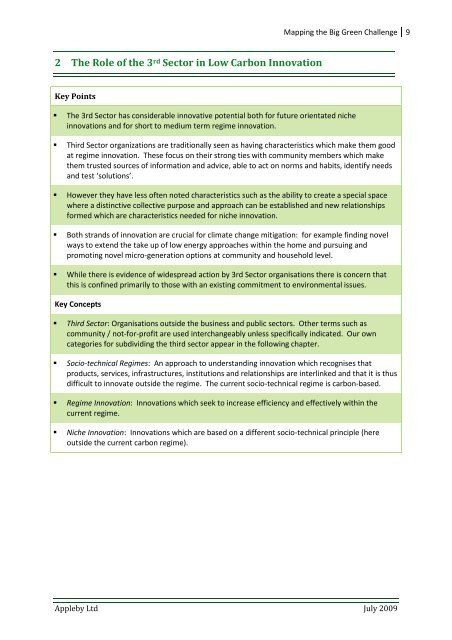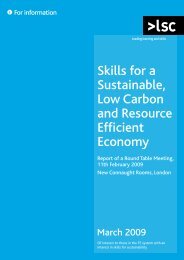Mapping the Big Green Challenge - The Skills & Learning ...
Mapping the Big Green Challenge - The Skills & Learning ...
Mapping the Big Green Challenge - The Skills & Learning ...
You also want an ePaper? Increase the reach of your titles
YUMPU automatically turns print PDFs into web optimized ePapers that Google loves.
<strong>Mapping</strong> <strong>the</strong> <strong>Big</strong> <strong>Green</strong> <strong>Challenge</strong> 92 <strong>The</strong> Role of <strong>the</strong> 3 rd Sector in Low Carbon InnovationKey Points<strong>The</strong> 3rd Sector has considerable innovative potential both for future orientated nicheinnovations and for short to medium term regime innovation.Third Sector organizations are traditionally seen as having characteristics which make <strong>the</strong>m goodat regime innovation. <strong>The</strong>se focus on <strong>the</strong>ir strong ties with community members which make<strong>the</strong>m trusted sources of information and advice, able to act on norms and habits, identify needsand test ‘solutions’.However <strong>the</strong>y have less often noted characteristics such as <strong>the</strong> ability to create a special spacewhere a distinctive collective purpose and approach can be established and new relationshipsformed which are characteristics needed for niche innovation.Both strands of innovation are crucial for climate change mitigation: for example finding novelways to extend <strong>the</strong> take up of low energy approaches within <strong>the</strong> home and pursuing andpromoting novel micro-generation options at community and household level.While <strong>the</strong>re is evidence of widespread action by 3rd Sector organisations <strong>the</strong>re is concern thatthis is confined primarily to those with an existing commitment to environmental issues.Key ConceptsThird Sector: Organisations outside <strong>the</strong> business and public sectors. O<strong>the</strong>r terms such ascommunity / not-for-profit are used interchangeably unless specifically indicated. Our owncategories for subdividing <strong>the</strong> third sector appear in <strong>the</strong> following chapter.Socio-technical Regimes: An approach to understanding innovation which recognises thatproducts, services, infrastructures, institutions and relationships are interlinked and that it is thusdifficult to innovate outside <strong>the</strong> regime. <strong>The</strong> current socio-technical regime is carbon-based.Regime Innovation: Innovations which seek to increase efficiency and effectively within <strong>the</strong>current regime.Niche Innovation: Innovations which are based on a different socio-technical principle (hereoutside <strong>the</strong> current carbon regime).Appleby Ltd July 2009











